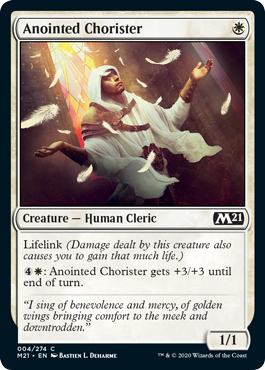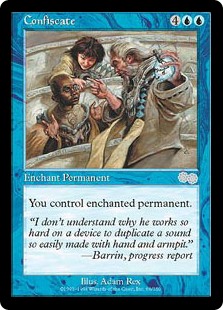It was my partner Tobey who first came up with the idea for a legacy Magic Game.
No, No. Not the Legacy format,” He told me, “A legacy-style game. Like Charterstone, or Pandemic Legacy. Every game played will change every other future game. Week by week players’ decisions will change what happens next, and those changes will be reflected by manipulating the cards in their deck.”
“Sounds great!” I said. “I would play the heck out of that. What do you want me to do?”
He told me my only job was to “write pretty words”, but here we are one year later and I’ve learned (very) basic graphic design, marketing, art direction, game design and a few other odd skills.
But my favorite job is “gimmick maker”. I tend to work like an idea factory, spitting out half-baked concepts on a gimmicky assembly line. Tobey is the poor factory floor worker who has to pick through the defects. His talent is making ideas work, and he does this by reducing a complicated idea to its most basic form.
I remember an early coffee shop meeting where we were brainstorming some of the Legacy style elements we wanted to include.
“We need to start small.” Tobey said, pulling out a few M21 cards. “We need to gradually show our players how to modify cards. Maybe tweak the mana cost on some overcosted cards that are otherwise unplayable… or change a creature type to something relevant.”
I nodded and took a sip of coffee. “Yeah that’s cool” I said. “Or we can start with a bang. The first duel takes place in the maelstrom between worlds. Once per turn you may take a land, crumple it into a little ball, and Chaos Orb it onto your opponent’s permanents.”

“Not that I’m opposed to destroying cards…” He started, diplomatically, “but we need to establish that cards can change before we crumple them up into Chaos Orbs. Start small, work from the basics.”
“Fair point…” I said, chewing my pencil. “What if we give players an emblem that lets them roll a d10 for a random keyword when a creature enters the battlefield. 10 gives industructable, 1 gives defender.”
“For week 1?” He said. “For that to work, we would need to introduce writing on cards, writing on cards mid-game, die rolling, and emblems. That’s four elements that we would need to ‘teach’ our players.”
“Ah.” I said, a bit deflated. “More simple. Ok. Um… I think we can begin by having them write a few keywords directly on the cards themselves. In between games. You know… for story reasons.”
Tobey nodded. “Perfect. And once we do that a few times to establish how this all works, we move up to the big stuff.”
“Gotcha.” I said. “But will it be exciting enough?”
Tobey put out an Anointed Chorister from his stack of cards. “What keyword makes this guy go from boring to broke?”
We both thought for a moment, and then I took out a pen and wrote ‘double strike’. “Look,” I said, “he went from draft chaffe to chase rare.”
“Keywords.” He said. “I think that’s where we start.”

“And we let them choose which one, that’s the fun part.”
He nodded. “Start small. Build a base. Work up from there. It’s just like teaching at the Kindergarten.”
I should mention, Tobey and I met in Taiwan while we were both working in a local Kindergarten. I don’t think we paid much attention to each other until I walked into the local card shop and saw he was the owner (“Great” My wife later said to me, “We found the local cardboard crack dealer.”).
Teaching together made working together on a new game convenient, but it also proved incredibly helpful in learning the principles of game design. Tobey was one of my first trainers when I started at the Kindergarten. I remember watching him teach a demo class, and I was floored with how he could turn every aspect of his classroom into a game.
For some perspective, I was teaching a class of manic 4 year olds who were in a constant bloodsport struggle for my full attention. If I so much as looked down to turn the page of a book I would look up to see at least one kid bleeding and three more in tears. God forbid I write on the whiteboard. I would turn to find they formed a twenty child high dogpile.

But in Tobey’s class all he had to do was say a word and they all sat down nicely on the floor together. Another word and they were reading aloud from their books, fingers following the passage one word at a time. The guy was like a child-friendly drill sergeant. He could make them sit and stand in formation!
Once, he set them off to practice handwriting in their workbooks and wandered off to talk to another teacher. “Aren’t they going to start an armed insurrection?” I asked him. He shook his head. “Nah, they like this part.”
I watched, bug-eyed, as the children finished writing in their books and lined up, seated, one by one at Tobey’s feet. “They are waiting for me to check their books.” He said. “If they did well, I’ll give them a sticker and they can play with toys.”
He explained, “They didn’t start out this way. We spent a whole week learning how to sit properly. Once they got that down, I added a new skill. Then another. This is a semester’s worth of work right here. Which is a real shame,” he added, “because I’ve got to start again in a few weeks.”

But that was the brunt of it. Start small. Build from the basics. Oh, and in the case of kindergarteners, make it more fun to follow the rules than to break them.
This is why we make such a good team. I never run out of cool ideas, and he’s been making games already for decades. I throw ideas at the wall and he breaks everything down to parse what is viable and what is ridiculous. I’m ready to revolutionize how we play Magic: The Gathering, and he is… well, sane.
But appreciating his process doesn’t keep me from trying to push the envelope a bit…
“Hey Tobey.” I said on the way to class one morning. “Let’s have our players team up with a treefolk. Then they can go outside and bury a couple of cards, and during the next game they can dig ‘em up and however many days they were underground, they enter the battlefield and create that many saprolings.”
“We’re designing a game, not an un-set.” He answered.
“Oh how about this one! They elect one card as their ‘general’ and every time they play it it gets a permanent +1/+1.”
“Too luck dependent. And it favors our reanimator-style deck archetype.” He said. “But there is a lot of potential design space there.”
“I’ve got a good one! We give them a card pack as a treasure type reward, but the contents are revealed face down, and they can only claim cards by winning a game of memory.”
“I don’t think–” He paused. “Ok, that’s a good one. There are a few kinks to work out but that would be a nice mid-chapter minigame.”
“Nice…” I said.
No promises of a memory mini-game anytime soon in MTG: Storyline, but throw me a bone and I’ll take it.
This sounds great – I’ve had a similar idea as a teaching tool. You start with a deck of completely vanilla Magic creatures to learn the rules, and then when you win a game, you can unlock new rules. Now you can give a creature flying! Trample! Flash! Etc. Your sorcery can become an instant! I think it’d be really valuable.
Wonderful! Yes, we found it’s incredibly satisfying to improve your cards and leave your own mark on them. Can’t wait until you can try.
Hi ! Love the concept. I’m a huge fan of legacy games (currently playing a Aeons End legacy campain and Betrayal legacy + clanck legacy are already bought for the next campains) and I play with other MTF fans. We would love to help playtest if you need help !
That would be wonderful! We’re in the middle of a major overhaul and would love to get a few totally new eye on it. Could I send you Chapter 1 to the email address you registered with? (a***n@d***.com?)